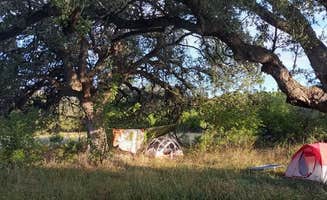Primitive camping near Burnet, Texas focuses on the Lake Georgetown area where the 26.2-mile Good Water Loop trail connects three free backcountry camping zones. Situated in central Texas with elevations between 780-970 feet, this terrain features limestone formations and juniper-oak woodlands typical of the Edwards Plateau. Summer temperatures frequently exceed 100°F with high humidity, making spring and fall the preferred camping seasons.
What to do
Shoreline exploration: At Sawyer Park Primitive Campsites, campers can find unofficial sites along the lakeshore. "We ended up not following our AllTrails after a fork in the road heading towards the campsite, and were pretty pooped so decided to camp there off Sawyer Campsite Rd. People had clearly used the shore as a campsite before as there was a makeshift fire pit and some cleared areas for tents. Water and views were beautiful," notes Alexandra.
Trail hiking: The complete circuit around Lake Georgetown offers varying terrain and difficulty levels. According to Troy W., the San Gabriel River Trail "passes through forests, grasslands, over some small hills and across a few tributaries." The trail's mixed coverage means planning for sun exposure, as "40% of the trail has some tree coverage, but 60% is exposed."
Water activities: Some campers access the primitive sites via water. At Walnut Springs Primitive Campground, Guillermo L. observed "a backpacking group, a group of people who canoed in, and ourselves. Large open area; four fire pits, four lamp hangers, four picnic tables, trees closer the trail and grassy areas closer to the water."
What campers like
Multiple access options: Walnut Springs Primitive Campground offers versatile entry points. Guillermo notes it "can be biked in from Camp Tejas four miles away or can hiking from Russell Park 2 mi away," making it accessible for various outdoor enthusiasts.
Natural camping areas: The primitive sites feature minimal development but natural spaces suitable for camping. At Sawyer Park, Troy W. describes, "There are a few areas with clear land or tent pads where you may camp. But there are also zones where you may simply camp wherever you can setup a tent or hammock."
Weekday solitude: For those seeking quiet, timing matters. Troy mentions that while on weekends "you may encounter scout troops practicing backpacking," during weekdays "you may not see a single person" on the trails and at campsites.
What you should know
Limited facilities: No modern amenities exist at these primitive sites. Troy cautions about Sawyer Park: "There is an old latrine at this site, but it is in poor shape and no-one really uses it. Be prepared to dig a cat hole."
Water planning: Despite camping near a lake, accessing water requires preparation. "While you may be hiking within site of Lake Georgetown, it is not always convenient to access the water. So carry plenty of water while hiking - at least 2 liters," advises Troy W.
Weather considerations: The central Texas climate creates challenging conditions. Guillermo enjoyed "a stay during a thunderstorm under the big trees" at Walnut Springs, while Alexandra experienced issues when "rain started pretty heavily (and being close to the water probably didn't help with humidity inside the tent) and our rain fly was unwilling to cooperate so we got a bit wet."
Tips for camping with families
Choose campsites strategically: Some locations are more suitable for groups with children. At Walnut Springs, the "large open area" with "picnic tables" and "trees closer the trail" provides space for families to spread out.
Manage hiking distances: Consider the length of hikes when planning with children. The Sawyer Park site "is about 5 miles from the Tejas Campground and 5 miles from Cedar Breaks Campground," notes Troy, making it a significant hike for younger campers.
Be prepared for trail conditions: Weather affects trail quality. Alexandra mentions, "The home back in the rain was fine. A couple slippery spots but very doable," indicating that while trails remain passable in wet conditions, extra caution with children is warranted.
Tips from RVers
No vehicle camping available: These dispersed camping areas are exclusively for tent camping with hike-in or boat-in access. None of the primitive sites accommodate RVs or vehicles of any kind.
Nearby developed alternatives: For those with RVs, consider staying at developed campgrounds and using the primitive sites for day trips. The primitive areas are connected to established campgrounds like Cedar Breaks and Tejas Camp by the Good Water Loop trail.
Parking considerations: When visiting the trail system, Troy advises, "Upon entering one of the access points, park your car for free near the trailhead. It is good to advise one of the park attendants that you will be hiking or place a note inside your car that you are hiking."


